What'sNEW July - September 2013
 Water on Mars "discovered" by Curiosity is actually not news at all, says Gil Levin, 27 Sep 2013. Water on Mars "discovered" by Curiosity is actually not news at all, says Gil Levin, 27 Sep 2013.
 5 Bold Claims of Alien Life, a compilation of 5 entries on Space.com, 20 Sep 2013. 5 Bold Claims of Alien Life, a compilation of 5 entries on Space.com, 20 Sep 2013.  Thanks, Google Alerts. Thanks, Google Alerts.
 Jamie Wallis et al., "Physical, Chemical and Mineral Properties of the Polonnaruwa Stones" [2Mb local pdf], presented at the Astrobiology XVI Conference in San Diego CA, 27 Aug 2013. Jamie Wallis et al., "Physical, Chemical and Mineral Properties of the Polonnaruwa Stones" [2Mb local pdf], presented at the Astrobiology XVI Conference in San Diego CA, 27 Aug 2013.
|
...the Polonnaruwa, Ratkinda and Girandanakotte stones maybe said to represent a new class of meteorite. However, bulk chemical compositions, trace elemental abundances, mineral compositionsand petrographic features all point to significant similarities with material of known non-terrestrial provenance. In the meantime, the presence of converted plagioclase feldspar to maskelynite, the presence of several high pressure/temperature polymorphs of olivine and SiO2, the observed high pressure disassociation of ilmenite into mixed oxides, the oxygen isotope compositions and the REE patterns all demonstrate the undeniably meteoritic origin of these stones. |
 Jamie Hamilton Wallis, Evidence of Panspermia: From Astronomy to Meteorites (20 Mb pdf), PhD Thesis at Cardiff University, 2014. Jamie Hamilton Wallis, Evidence of Panspermia: From Astronomy to Meteorites (20 Mb pdf), PhD Thesis at Cardiff University, 2014. 
 Could Life Have Survived a Fall to Earth?, European Planetary Science Congress (+ScienceDaily +RedOrbit), 12 Sep 2013. Could Life Have Survived a Fall to Earth?, European Planetary Science Congress (+ScienceDaily +RedOrbit), 12 Sep 2013.  Thanks, Ken Jopp & Google Alerts. Thanks, Ken Jopp & Google Alerts.
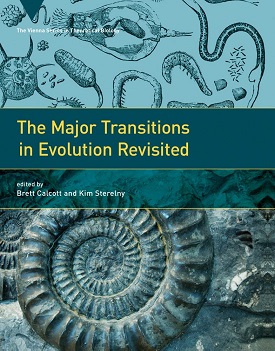 A major problem with all origin-of-life theories — how did biological "self-preservation" arise? — is something we should not continue to ignore, according to Australian philosopher Pamela Lyon:
A major problem with all origin-of-life theories — how did biological "self-preservation" arise? — is something we should not continue to ignore, according to Australian philosopher Pamela Lyon:
"...Let me be clear: I do not doubt that self-preservation—the inchoate striving to maintain system integrity against threat and to perpetuate existence via reproduction—is the default existential condition of living things, present and past. But the emergence of that default state needs to be explained. This is the truck-sized gap in the origins and transitions narratives that Dawkinsian selfishness obscures." (p 107)
 Lyon's essay is among fourteen in a collection that followed a workshop at the Konrad Lorenz Institute for Evolution and Cognition Research. The workshop, held in 2007, was designed to extend the research project promoted by John Maynard-Smith and Eörs Szathmáry with the publication, in 1995, of The Major Transitions in Evolution. Her essay exposes a profound, essential issue. Good job, Pamela Lyon!
Lyon's essay is among fourteen in a collection that followed a workshop at the Konrad Lorenz Institute for Evolution and Cognition Research. The workshop, held in 2007, was designed to extend the research project promoted by John Maynard-Smith and Eörs Szathmáry with the publication, in 1995, of The Major Transitions in Evolution. Her essay exposes a profound, essential issue. Good job, Pamela Lyon!
 Pamela Lyon "To be or not to be: Where is self-preservation in evolutionary theory?" p 105-125, The Major Transitions in Evolution Revisited, B. Calcott and K. Sterelny, eds., ISBN:9780262015240, MIT Press, Apr 2011. Pamela Lyon "To be or not to be: Where is self-preservation in evolutionary theory?" p 105-125, The Major Transitions in Evolution Revisited, B. Calcott and K. Sterelny, eds., ISBN:9780262015240, MIT Press, Apr 2011.
 The RNA World... and The RNA World... and  The Second Law... both reference The Major Transitions in Evolution. The Second Law... both reference The Major Transitions in Evolution.
...Bacteriophages serve to shuttle genes between diverse ecosystems... and even introduce novel genes to new environments. ...The migration of bacteria, or of the megafauna that bacteria infect, allows phages to traverse the globe. ...Bacteriophages are capable of forming and collapsing entire ecosystems.
 Going Viral by Breeann Kirby and Jeremy J. Barr, The Scientist, 1 Sep 2013. Going Viral by Breeann Kirby and Jeremy J. Barr, The Scientist, 1 Sep 2013.
 Viruses and Other Gene Transfer Mechanisms is the related local webpage. Viruses and Other Gene Transfer Mechanisms is the related local webpage.
What'sNEW about HGT  | |
Metabolic systems ...contain a latent potential for evolutionary innovations with non-adaptive origins. Our observations suggest that many more metabolic traits may have non-adaptive origins than is appreciated at present. Two bioinformaticians observe that bacteria are "pre-adapted" for nutrients they may have never encountered. Using computers to analyse existing genomic sequences, they showed that, among strains of E. coli that can metabolise glucose, 96% can metabolise other nutrients, up to as many as 44 out of the 50 nutrients considered.
Traits with "non-adaptive" origins are hard to explain with the mainstream theory of evolution. But genomes with programs that are "pre-adapted" for unencountered situations are a standard prediction of cosmic ancestry. The report of this analsis concludes, ...The pervasiveness of non-adaptive traits may require a rethinking of the early origins of beneficial traits.
 Aditya Barve and Andreas Wagner, "A latent capacity for evolutionary innovation through exaptation in metabolic systems" [abstract], doi:10.1038/nature12301, p 203-206 v 500, Nature, 8 Aug 2013. Aditya Barve and Andreas Wagner, "A latent capacity for evolutionary innovation through exaptation in metabolic systems" [abstract], doi:10.1038/nature12301, p 203-206 v 500, Nature, 8 Aug 2013.
 Neo-Darwinism: The Current Paradigm is a related local webpage. Neo-Darwinism: The Current Paradigm is a related local webpage.
 Thanks for feedback, Ken Jopp and Thanks for feedback, Ken Jopp and  Pedro Pereira. Pedro Pereira.
Life on Earth may have come from Mars, according to Steve Benner, biochemist and founder of the Westheimer Institute of Science and Technology in Gainesville FL. He notes that minerals containing boron and molybdenum would have been more abundant there, and these may provide templates that might help to sort out any prebiotic soup.

"Basically, we went looking on Mars because the origins-of-life options on Earth just aren't looking very good," Benner said. For whatever reason, the story is getting a lot of coverage. Of course, if life came to Earth from Mars, that is called panspermia. Welcome aboard, Steve!
 Earth life 'may have come from Mars' by Simon Redfern, BBC News, 28 Aug 2013. Earth life 'may have come from Mars' by Simon Redfern, BBC News, 28 Aug 2013.
 We All May Be Martians, Astrobiology Magazine, 29 Aug 2013. We All May Be Martians, Astrobiology Magazine, 29 Aug 2013.
 Are We Martians After All? by Govert Schilling, Science Now, 29 Aug 2013. Are We Martians After All? by Govert Schilling, Science Now, 29 Aug 2013.
 If Life Traveled From Mars To Earth ...Who Are We? by Scott Simon, NPR, 31 Aug 2013. If Life Traveled From Mars To Earth ...Who Are We? by Scott Simon, NPR, 31 Aug 2013.
 Did Life on Earth Come From Mars? by Marc Kaufman for National Geographic, 5 Sep 2013. Did Life on Earth Come From Mars? by Marc Kaufman for National Geographic, 5 Sep 2013.
 The RNA World... and The RNA World... and  Life on Mars! are related local webpages. Life on Mars! are related local webpages.
 Thanks, Sascha Wageringel, Bob Sweeney, Richard Hoover, Ellen Klyce, George Stratton, The Commercial Appeal, Google Alerts and Stan Franklin. Thanks, Sascha Wageringel, Bob Sweeney, Richard Hoover, Ellen Klyce, George Stratton, The Commercial Appeal, Google Alerts and Stan Franklin.
 Astrobiology XVI will take place Tuesday, 27 August 2013, in San Diego, California. Some of the world's leading experts, including conference co-chairs Richard Hoover, Gil Levin, Alexei Rozanov and Chandra Wickramasinghe, will discuss the latest developments in astrobiology. Of special interest to us, the international team studying the Polonnaruwa meteorite that fell 29 Dec 2012, will present evidence for life in it. At an evening session (8-10 PM, Marriott Hotel, Marina E), conference panelists will recap some of the news and answer questions from the audience. The evening session, titled "Life in the Cosmos," is open to all; science reporters are especially welcome.
Astrobiology XVI will take place Tuesday, 27 August 2013, in San Diego, California. Some of the world's leading experts, including conference co-chairs Richard Hoover, Gil Levin, Alexei Rozanov and Chandra Wickramasinghe, will discuss the latest developments in astrobiology. Of special interest to us, the international team studying the Polonnaruwa meteorite that fell 29 Dec 2012, will present evidence for life in it. At an evening session (8-10 PM, Marriott Hotel, Marina E), conference panelists will recap some of the news and answer questions from the audience. The evening session, titled "Life in the Cosmos," is open to all; science reporters are especially welcome.
 Instruments, Methods, and Missions for Astrobiology XVI, Conference 8865, 27 Aug, of the SPIE Optics + Photonics 2013 Conference, San Diego Convention Center, 25-29 Aug 2013. Instruments, Methods, and Missions for Astrobiology XVI, Conference 8865, 27 Aug, of the SPIE Optics + Photonics 2013 Conference, San Diego Convention Center, 25-29 Aug 2013.
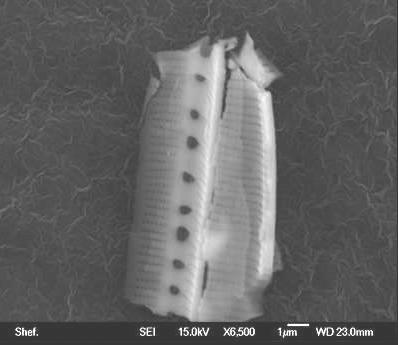 British astrobiologists have recovered a diatom fragment from 25 km high in the atmosphere, with balloon-borne equipment flown from Chester, NW England, 31 July. The biological nature of the fragment is beyond doubt, and the report makes a strong case for its arrival from space. Testing the particle's isotope ratios could discern its provenance, but this requires a special mass spectrometer. Grant money for this investigation is available, if a NanoSIMS or equivalent facility becomes interested.
British astrobiologists have recovered a diatom fragment from 25 km high in the atmosphere, with balloon-borne equipment flown from Chester, NW England, 31 July. The biological nature of the fragment is beyond doubt, and the report makes a strong case for its arrival from space. Testing the particle's isotope ratios could discern its provenance, but this requires a special mass spectrometer. Grant money for this investigation is available, if a NanoSIMS or equivalent facility becomes interested.
 Milton Wainwright et al., "Isolation of a Diatom Frustule Fragment from the Lower Stratosphere (22-27Km)-Evidence for a Cosmic Origin" [local pdf], p 1063-1078 v 22, Journal of Cosmology, Aug 2013. Milton Wainwright et al., "Isolation of a Diatom Frustule Fragment from the Lower Stratosphere (22-27Km)-Evidence for a Cosmic Origin" [local pdf], p 1063-1078 v 22, Journal of Cosmology, Aug 2013.
 An Atmospheric Test of Cometary Panspermia is a related local webpage. An Atmospheric Test of Cometary Panspermia is a related local webpage.
 Milton Wainwright comments, 10 Aug 2013. Milton Wainwright comments, 10 Aug 2013.
 Proof of alien life?..., a rebuttal by Terry Kee, The Conversation (+PhysOrg.com), 20 Sep 2013. Proof of alien life?..., a rebuttal by Terry Kee, The Conversation (+PhysOrg.com), 20 Sep 2013.
Did NASA's Opportunity rover find evidence for life on Mars in 2004? Apparent fossils photographed in Meridiani Planum on Sol 34 (27 February) of that mission look to several experts like fragments of crinoids, primitive sea animals related to starfish and sea urchins. But within 3 hours of taking the photo, NASA used the Rock Abrasion Tool (RAT) to completely obliterate the likely fossils. Why did they not, instead, take more photos from other angles, at different times, etc., and then deploy appropriate experts to examine the photos? And/or look for anything similar in the vicinity? Does NASA really want to know if there is, or ever was, life on Mars? It seems not!
 Thanks, Richard Hoover. Thanks, Richard Hoover.
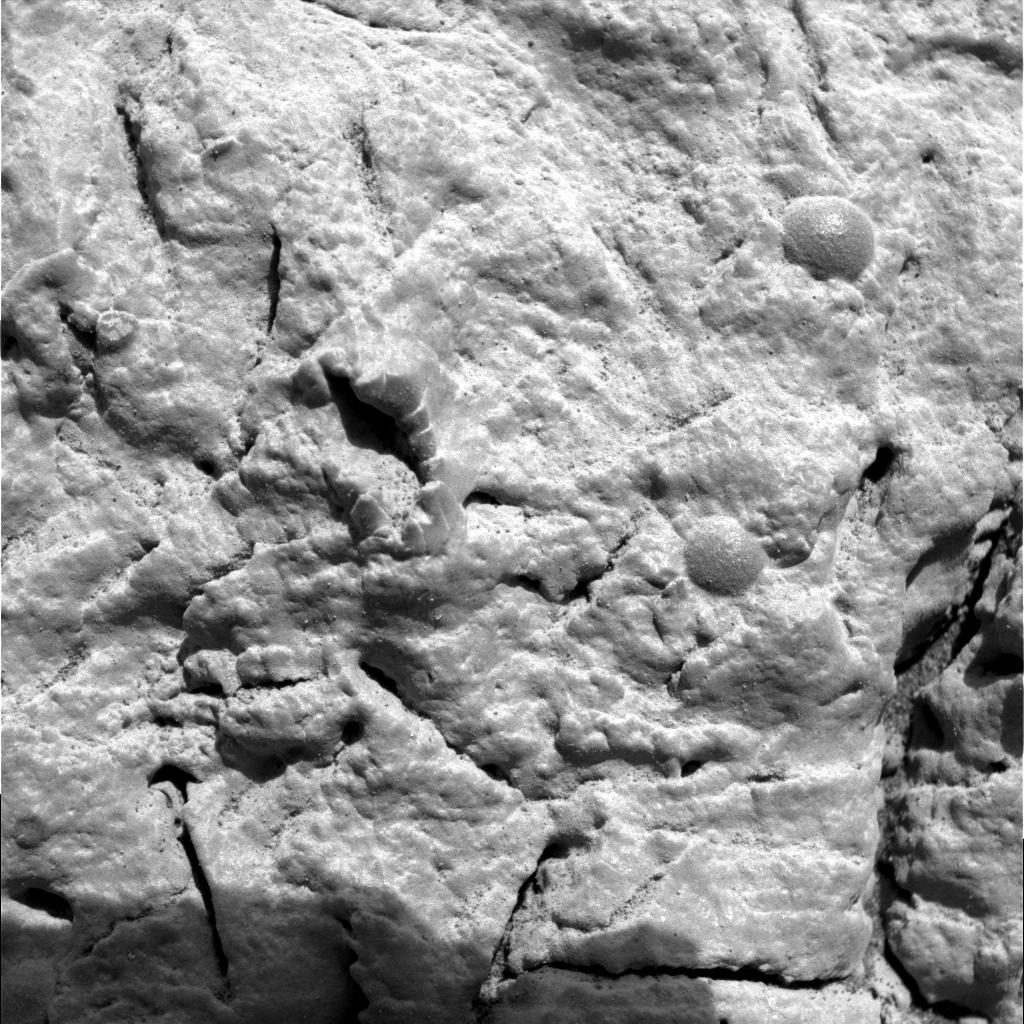
| 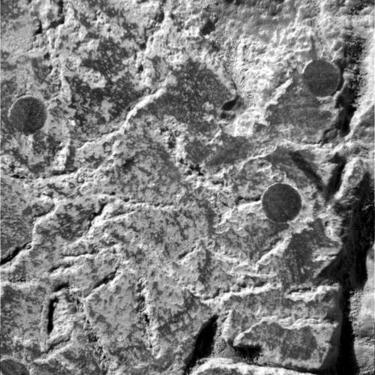
| | The Microscopic Imager on Opportunity took three nearly identical photos within less than 5 minutes including this photo at 11:30:35 local solar time, sol 34 (field of view 3x3 cm.) Features characteristic of crinoids include branching, segmenting, the flat-faced triangular crotch and the cup or "crown" structure, all appropriate in size and arrangement. [NASA source image | local copy | with our notes].
| The same camera later took three more photos in succession including this photo at 14:31:53 on Sol 34. With the RAT, NASA has ground away the fossil and nearby raised features, and the debris has been swept off. The surrounding "blueberries" (one ruptured?) now appear as dark circles (without layering typical of mineral accretions.) [NASA source image | local copy]
|
 Mars Exploration Rover Mission: Multimedia: All Raw Images: Opportunity: Microscopic Imager: Sol 034. Mars Exploration Rover Mission: Multimedia: All Raw Images: Opportunity: Microscopic Imager: Sol 034.
 Mars Exploration Rover Mission: Multimedia: All Raw Images: Opportunity: Microscopic Imager: Sol 035. The following day, NASA took 8 more images of the same area abraded by the RAT. Why not before the obliteration??? Mars Exploration Rover Mission: Multimedia: All Raw Images: Opportunity: Microscopic Imager: Sol 035. The following day, NASA took 8 more images of the same area abraded by the RAT. Why not before the obliteration???
 Rock Abrasion Tool (RAT), information page at NASA. Rock Abrasion Tool (RAT), information page at NASA.
 The Curious Case of the NASA Crinoid Cover-Up (with crinoid fossils for comparison), by Richard C. Hoagland, 2004. The Curious Case of the NASA Crinoid Cover-Up (with crinoid fossils for comparison), by Richard C. Hoagland, 2004.
Dr R Raynal suggests that the fossil is a different animal, 11 Aug 2013.
 Evidence from Opportunity's Microscopic Imager for Water on Meridiani Planum [local PDF], by K. E. Herkenhoff, S. W. Squyres et al., doi:10.1126/science.1105286, Science, 03 Dec 2004. See Fig. 4. Evidence from Opportunity's Microscopic Imager for Water on Meridiani Planum [local PDF], by K. E. Herkenhoff, S. W. Squyres et al., doi:10.1126/science.1105286, Science, 03 Dec 2004. See Fig. 4.
 Life on Mars! is the main related local webpage. Life on Mars! is the main related local webpage.
 02 Mar 2004: Meridiani Planum was wet — NASA's observation on Sol 28. 02 Mar 2004: Meridiani Planum was wet — NASA's observation on Sol 28.
 28 Oct 2015: The fossil from Sol 34 compared to earthly fossils with comments and updates. 28 Oct 2015: The fossil from Sol 34 compared to earthly fossils with comments and updates.
 Milton Wainwright et al., "Typical Meteoritic Worm-like Forms Seen in the Polonnaruwa Meteorite" [local pdf], n 12 v 22, Journal of Cosmology, Jul 2013. Milton Wainwright et al., "Typical Meteoritic Worm-like Forms Seen in the Polonnaruwa Meteorite" [local pdf], n 12 v 22, Journal of Cosmology, Jul 2013.
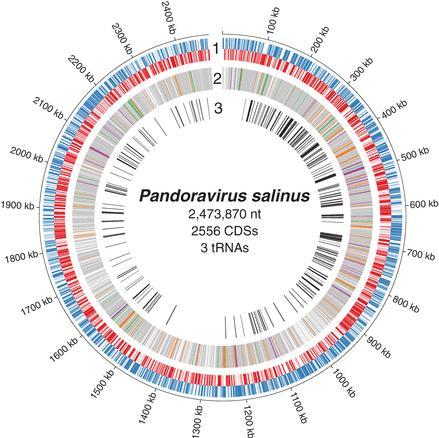 Giant viruses, bigger than many bacteria, have been discovered by French biologists. One species in salt water off Chile, and one in fresh water in Australia, had dsDNA genomes of approximately 2.5 and 1.9 million nucleotide pairs, respectively. The new viruses have been designated Pandoraviruses. "Both pandoraviruses lack genes for energy production and can't actually produce a protein on their own, fulfilling the definition of virus." The larger one, P. salinus (genome illustrated) has 2,556 likely protein-coding sequences (CDSs). Only 7%, have recognizable homologs. "What the hell is going on with the other genes?" Another big surprise for darwinism, and perfectly welcome news for cosmic ancestry.
Giant viruses, bigger than many bacteria, have been discovered by French biologists. One species in salt water off Chile, and one in fresh water in Australia, had dsDNA genomes of approximately 2.5 and 1.9 million nucleotide pairs, respectively. The new viruses have been designated Pandoraviruses. "Both pandoraviruses lack genes for energy production and can't actually produce a protein on their own, fulfilling the definition of virus." The larger one, P. salinus (genome illustrated) has 2,556 likely protein-coding sequences (CDSs). Only 7%, have recognizable homologs. "What the hell is going on with the other genes?" Another big surprise for darwinism, and perfectly welcome news for cosmic ancestry.
In the figure, the concentric circles represent:
1, CDSs positions on the direct (blue) and reverse (red) strands; 2, CDSs with a best match within eukaryotes (orange), bacteria (green), and viruses (purple); and CDSs with MORN repeats, ankyrin repeats, and F-box domain motifs (white); CDSs with no match (gray); 3, CDSs whose protein products were identified in the proteome of purified P. salinus particles.
 Nadège Philippe, Matthieu Legendre et al., "Pandoraviruses: Amoeba Viruses with Genomes Up to 2.5 Mb Reaching That of Parasitic Eukaryotes" [abstract], doi:10.1126/science.1239181, p 281-286 v 341, Science, 19 Jul 2013; and commentary: Nadège Philippe, Matthieu Legendre et al., "Pandoraviruses: Amoeba Viruses with Genomes Up to 2.5 Mb Reaching That of Parasitic Eukaryotes" [abstract], doi:10.1126/science.1239181, p 281-286 v 341, Science, 19 Jul 2013; and commentary:
 Elizabeth Pennisi, "Ever-Bigger Viruses Shake Tree of Life" [summary], doi:10.1126/science.341.6143.226, p 226-227 v 341, Science, 19 Jul 2013. Elizabeth Pennisi, "Ever-Bigger Viruses Shake Tree of Life" [summary], doi:10.1126/science.341.6143.226, p 226-227 v 341, Science, 19 Jul 2013.
 Giant viruses open Pandora's box, doi:10.1038/nature.2013.13410, by Ed Yong, Nature News, 18 Jul 2013. Giant viruses open Pandora's box, doi:10.1038/nature.2013.13410, by Ed Yong, Nature News, 18 Jul 2013.
 Never-before-seen GIANT virus... by Emma Innes, DailyMail.co.uk, 19 Jul 2013. Never-before-seen GIANT virus... by Emma Innes, DailyMail.co.uk, 19 Jul 2013.
 Viruses and Other Gene Transfer Mechanisms is the main related local webpage. Viruses and Other Gene Transfer Mechanisms is the main related local webpage.
What'sNEW about HGT  | |
 Thanks, Aya Ogawa (Ron McGhee?), Jerry Chancellor and George Stratton. Thanks, Aya Ogawa (Ron McGhee?), Jerry Chancellor and George Stratton.
 The Case for Alien Life by Sarah Fecht, Popular Mechanics, 1 Aug 2013 (+Arizona State University +PhysOrg.com, 15 Jul 2013). The Case for Alien Life by Sarah Fecht, Popular Mechanics, 1 Aug 2013 (+Arizona State University +PhysOrg.com, 15 Jul 2013).  Thanks, Stan Franklin. Thanks, Stan Franklin.
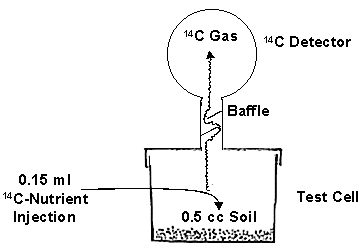 Gilbert Levin, Arizona State University and former team leader of the Viking Mars Landing mission, presents the argument that their 1976 experiment with the Viking lander discovered life on Mars. This speech was delivered at the 2013 Humans to Mars Summit, May 7 at George Washington University.
Gilbert Levin, Arizona State University and former team leader of the Viking Mars Landing mission, presents the argument that their 1976 experiment with the Viking lander discovered life on Mars. This speech was delivered at the 2013 Humans to Mars Summit, May 7 at George Washington University.
 Life on Mars Discovered in 1976?, 31 min. YouTube video posted by Ben Deniston, 8 May 2013. Life on Mars Discovered in 1976?, 31 min. YouTube video posted by Ben Deniston, 8 May 2013.
 Research on Mars — Papers by Gilbert V. Levin, Ph.D. Research on Mars — Papers by Gilbert V. Levin, Ph.D.
 Life on Mars! has a special section, What'sNEW: Viking. Life on Mars! has a special section, What'sNEW: Viking.
 Thanks, belatedly, Kevin Keogh. Thanks, belatedly, Kevin Keogh.
...The team found genetic sequences from crustaceans, mollusks, sea anemones, and fish.... in water from Lake Vostok.
 What's Really Going on in Lake Vostok? by Carolyn Gramling, Science NOW, 9 Jul 2013. What's Really Going on in Lake Vostok? by Carolyn Gramling, Science NOW, 9 Jul 2013.
 Antarctic Lake Vostok 'might have fish', BBC News, 8 Jul 2013. Antarctic Lake Vostok 'might have fish', BBC News, 8 Jul 2013.
 In Subglacial Lake, Surprising Life Goes On, Newswise, 5 Jul 2013. In Subglacial Lake, Surprising Life Goes On, Newswise, 5 Jul 2013.
 Yury M. Shtarkman, Zeynep A. Koçer et al., "Subglacial Lake Vostok (Antarctica) Accretion Ice Contains a Diverse Set of Sequences from Aquatic, Marine and Sediment-Inhabiting Bacteria and Eukarya" [html], doi:10.1371/journal.pone.0067221, 8(7): e67221, PLoS ONE, 3 Jul 2013. Yury M. Shtarkman, Zeynep A. Koçer et al., "Subglacial Lake Vostok (Antarctica) Accretion Ice Contains a Diverse Set of Sequences from Aquatic, Marine and Sediment-Inhabiting Bacteria and Eukarya" [html], doi:10.1371/journal.pone.0067221, 8(7): e67221, PLoS ONE, 3 Jul 2013.
 Life on Europa, Other Moons, Other Planets? is a local webpage with related links. Life on Europa, Other Moons, Other Planets? is a local webpage with related links.  Thanks, Bob Sweeney. Thanks, Bob Sweeney.
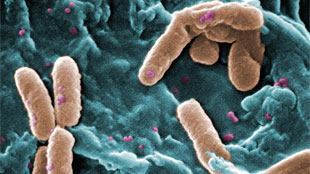 Bacterial DNA in human genomes is confirmed. Bacterial genes in humans were already noticed, in 2001, when the the human genome was sequenced, but that surprise was subsequently disputed. The new data seem sure. The evidence comes from the University of Maryland School of Medicine, and the transferred sequences are apparently more prevalent in cancer cells. (Pictured: one donor species, pseudomonas.)
Bacterial DNA in human genomes is confirmed. Bacterial genes in humans were already noticed, in 2001, when the the human genome was sequenced, but that surprise was subsequently disputed. The new data seem sure. The evidence comes from the University of Maryland School of Medicine, and the transferred sequences are apparently more prevalent in cancer cells. (Pictured: one donor species, pseudomonas.)
In cosmic ancestry, new genetic programs must be acquired by some form of horizontal gene transfer (HGT). The observed bacterial DNA was apparently acquired through an RNA intermediate. After transfer, newly acquired genes need testing and optimising. Sometimes they will turn out to be useless or even harmful. The harm may be manifest as cancer. Or perhaps cancer cells are more likely to acquire new genes. These examples are seen in somatic cells, but HGT often also reaches germline cells, as the report mentions. The news from Maryland is entirely plausible to us.
 David R. Riley, Karsten B. Sieber et al., "Bacteria-Human Somatic Cell Lateral Gene Transfer Is Enriched in Cancer Samples" [html], doi:10.1371/journal.pcbi.1003107, 9(6): e1003107, PLoS Comput Biol, 20 Jun 2013. David R. Riley, Karsten B. Sieber et al., "Bacteria-Human Somatic Cell Lateral Gene Transfer Is Enriched in Cancer Samples" [html], doi:10.1371/journal.pcbi.1003107, 9(6): e1003107, PLoS Comput Biol, 20 Jun 2013.
 Bacterial DNA in Human Genomes by Ed Yong, TheScientist, 20 Jun 2013. Bacterial DNA in Human Genomes by Ed Yong, TheScientist, 20 Jun 2013.
 Viruses and Other Gene Transfer Mechanisms is a related local webpage. Viruses and Other Gene Transfer Mechanisms is a related local webpage.
What'sNEW about HGT  | |
 Thanks for an alert, Stan Franklin. Thanks for an alert, Stan Franklin.
|


 Astrobiology XVI will take place Tuesday, 27 August 2013, in San Diego, California. Some of the world's leading experts, including conference co-chairs Richard Hoover, Gil Levin, Alexei Rozanov and Chandra Wickramasinghe, will discuss the latest developments in astrobiology. Of special interest to us, the international team studying the Polonnaruwa meteorite that fell 29 Dec 2012, will present evidence for life in it. At an evening session (8-10 PM, Marriott Hotel, Marina E), conference panelists will recap some of the news and answer questions from the audience. The evening session, titled "Life in the Cosmos," is open to all; science reporters are especially welcome.
Astrobiology XVI will take place Tuesday, 27 August 2013, in San Diego, California. Some of the world's leading experts, including conference co-chairs Richard Hoover, Gil Levin, Alexei Rozanov and Chandra Wickramasinghe, will discuss the latest developments in astrobiology. Of special interest to us, the international team studying the Polonnaruwa meteorite that fell 29 Dec 2012, will present evidence for life in it. At an evening session (8-10 PM, Marriott Hotel, Marina E), conference panelists will recap some of the news and answer questions from the audience. The evening session, titled "Life in the Cosmos," is open to all; science reporters are especially welcome.
 Giant viruses, bigger than many bacteria, have been discovered by French biologists. One species in salt water off Chile, and one in fresh water in Australia, had dsDNA genomes of approximately 2.5 and 1.9 million nucleotide pairs, respectively. The new viruses have been designated Pandoraviruses. "Both pandoraviruses lack genes for energy production and can't actually produce a protein on their own, fulfilling the definition of virus." The larger one, P. salinus (genome illustrated) has 2,556 likely protein-coding sequences (CDSs). Only 7%, have recognizable homologs. "What the hell is going on with the other genes?" Another big surprise for darwinism, and perfectly welcome news for cosmic ancestry.
Giant viruses, bigger than many bacteria, have been discovered by French biologists. One species in salt water off Chile, and one in fresh water in Australia, had dsDNA genomes of approximately 2.5 and 1.9 million nucleotide pairs, respectively. The new viruses have been designated Pandoraviruses. "Both pandoraviruses lack genes for energy production and can't actually produce a protein on their own, fulfilling the definition of virus." The larger one, P. salinus (genome illustrated) has 2,556 likely protein-coding sequences (CDSs). Only 7%, have recognizable homologs. "What the hell is going on with the other genes?" Another big surprise for darwinism, and perfectly welcome news for cosmic ancestry.

 Bacterial DNA in human genomes is confirmed. Bacterial genes in humans were already noticed, in 2001, when the the human genome was sequenced, but that surprise was subsequently disputed. The new data seem sure. The evidence comes from the University of Maryland School of Medicine, and the transferred sequences are apparently more prevalent in cancer cells. (Pictured: one donor species, pseudomonas.)
Bacterial DNA in human genomes is confirmed. Bacterial genes in humans were already noticed, in 2001, when the the human genome was sequenced, but that surprise was subsequently disputed. The new data seem sure. The evidence comes from the University of Maryland School of Medicine, and the transferred sequences are apparently more prevalent in cancer cells. (Pictured: one donor species, pseudomonas.)
 Lyon's essay is among fourteen in a collection that followed a workshop at the Konrad Lorenz Institute for Evolution and Cognition Research. The workshop, held in 2007, was designed to extend the research project promoted by John Maynard-Smith and Eörs Szathmáry with the publication, in 1995, of The Major Transitions in Evolution. Her essay exposes a profound, essential issue. Good job, Pamela Lyon!
Lyon's essay is among fourteen in a collection that followed a workshop at the Konrad Lorenz Institute for Evolution and Cognition Research. The workshop, held in 2007, was designed to extend the research project promoted by John Maynard-Smith and Eörs Szathmáry with the publication, in 1995, of The Major Transitions in Evolution. Her essay exposes a profound, essential issue. Good job, Pamela Lyon!

